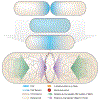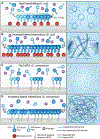FtsZ dynamics in bacterial division: What, how, and why?
- PMID: 33220539
- PMCID: PMC7925355
- DOI: 10.1016/j.ceb.2020.10.013
FtsZ dynamics in bacterial division: What, how, and why?
Abstract
Bacterial cell division is orchestrated by the divisome, a protein complex centered on the tubulin homolog FtsZ. FtsZ polymerizes into a dynamic ring that defines the division site, recruits downstream proteins, and directs peptidoglycan synthesis to drive constriction. Recent studies have documented treadmilling of FtsZ polymer clusters both in cells and in vitro. Emerging evidence suggests that FtsZ dynamics are regulated largely by intrinsic properties of FtsZ itself and by the membrane anchoring protein FtsA. Although FtsZ dynamics are broadly required for Z-ring assembly, their role(s) during constriction may vary among bacterial species. These recent advances set the stage for future studies to investigate how FtsZ dynamics are physically and/or functionally coupled to peptidoglycan metabolic enzymes to direct efficient division.
Keywords: Bacteria; Cell division; Cell wall; Cytokinesis; Cytoskeleton; FtsZ; Peptidoglycan; Treadmilling.
Copyright © 2020 Elsevier Ltd. All rights reserved.
Conflict of interest statement
Conflict of interest statement Nothing declared.
Figures



References
-
- Schumacher MA: Bacterial Nucleoid Occlusion: Multiple Mechanisms for Preventing Chromosome Bisection During Cell Division. Subcell Biochem 2017, 84:267–298. - PubMed
-
-
Walker BE, Männik J, Männik J: Transient Membrane-Linked FtsZ Assemblies Precede Z-Ring Formation in Escherichia coli. Curr Biol 2020, 30:499–508.e6.
* The authors combine a “mother machine” with time-lapse imaging to create a high-throughput method for observing E. coli FtsZ filaments throughout the cell over the entire cell cycle. They find that FtsZ forms short polymers that are transiently associated with the membrane along the length of the cell prior to Z-ring formation.
-
Publication types
MeSH terms
Substances
Grants and funding
LinkOut - more resources
Full Text Sources
Other Literature Sources
Molecular Biology Databases

